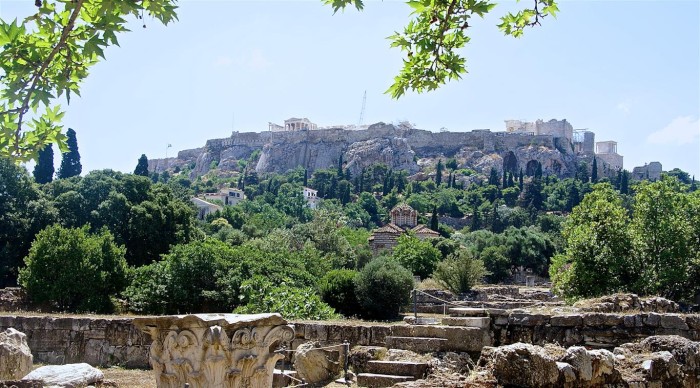Berkeley East Arrives
Port Everglades, FL Sigrun Bolten arrived in Port Everglades Florida as scheduled on December 15, 2006. We were...

While planning our trip to Athens, we read a lot of opinions, much of which were that Athens is just a big, busy, dirty city with only one redeeming feature, the Acropolis. We even met people who said it wasn’t worth a visit. But with our newfound love of Greek ruins, we had to go.
Unfortunately, Athens is not on the water, so we could not take Berkeley East right into town. So we parked BE in a nearby marina, booked a hotel, packed a bag and hopped the train into the city. Hotels for cruisers are heaven, especially if they have ac, good shower heads and lots of water pressure. Ours did, and it was difficult to tear ourselves away to see the sites. By the time we went outside, it was extremely hot and windy, so we decided to just wander a bit and save the major attraction for the next morning, when it was cooler and less crowded. But as we began to make our way through Athens’ meandering streets, glimpses of the Acropolis kept coming into view. We saw a bit behind a building, a little appeared at the end of an alley. Then we stepped into a clearing and there it was, sitting majestically high on the hill. Soon we were walking up the hill, sweating profusely in the heat of the day, fighting the wind with every step. It seemed that we just couldn’t stop; it really was spectacular and it was calling to us.


The term Acropolis means “High City.” Commissioned in the 5th century BC, the ancient city of upper Athens towers above today’s modern metropolis. We spent the rest of the day seeing the Acropolis from all sides and every angle, visiting the museum, and then venturing out to see how it looked in the night (with a brief hotel stop for multiple showers, bubble baths and lots of ac time).







So given that the Acropolis is Athens’ main feature, you would think we were done there. But we spent two more days and barely scratched the surface of this fascinating city. Athens is full of incredible ancient monuments surrounded by cement apartment blocks, a contrast so odd, and yet so beautiful. Just the idea that the Athenians have been able to preserve so many sites on valuable land in a bustling commercial center is mindboggling.


So is Athens a big, busy, dirty city? It is very big, but if you take the time to really see the city, you find that it is actually a conglomeration of small neighborhoods, each with unique charms, and we managed to walk everywhere we went. And it is very busy, with chaotic traffic jams and Athenians hurrying through the streets amid tourists and historic treasures, but it had also had a very friendly vibe. As far being dirty, ruins are typically not landscaped, so dirt is a natural thing.


Changing of the guard at the tomb of the unknown soldier.

The Erechtheion, an ancient Greek temple on the north side of the Acropolis, was dedicated to both Athena and Poseidon.


Considered the best-preserved ancient Greek temple in the world, the Hephaistion has retained all of its columns and pediments intact.

The colossal Temple of Olympian Zeus sits in the center of Athens, with the Acropolis up on the hill behind.

Hadrian’s Arch, a marble gateway built in AD 131, was once intended to separate the ancient and imperial sections of Athens, Hadrian’s Arch.
Comm